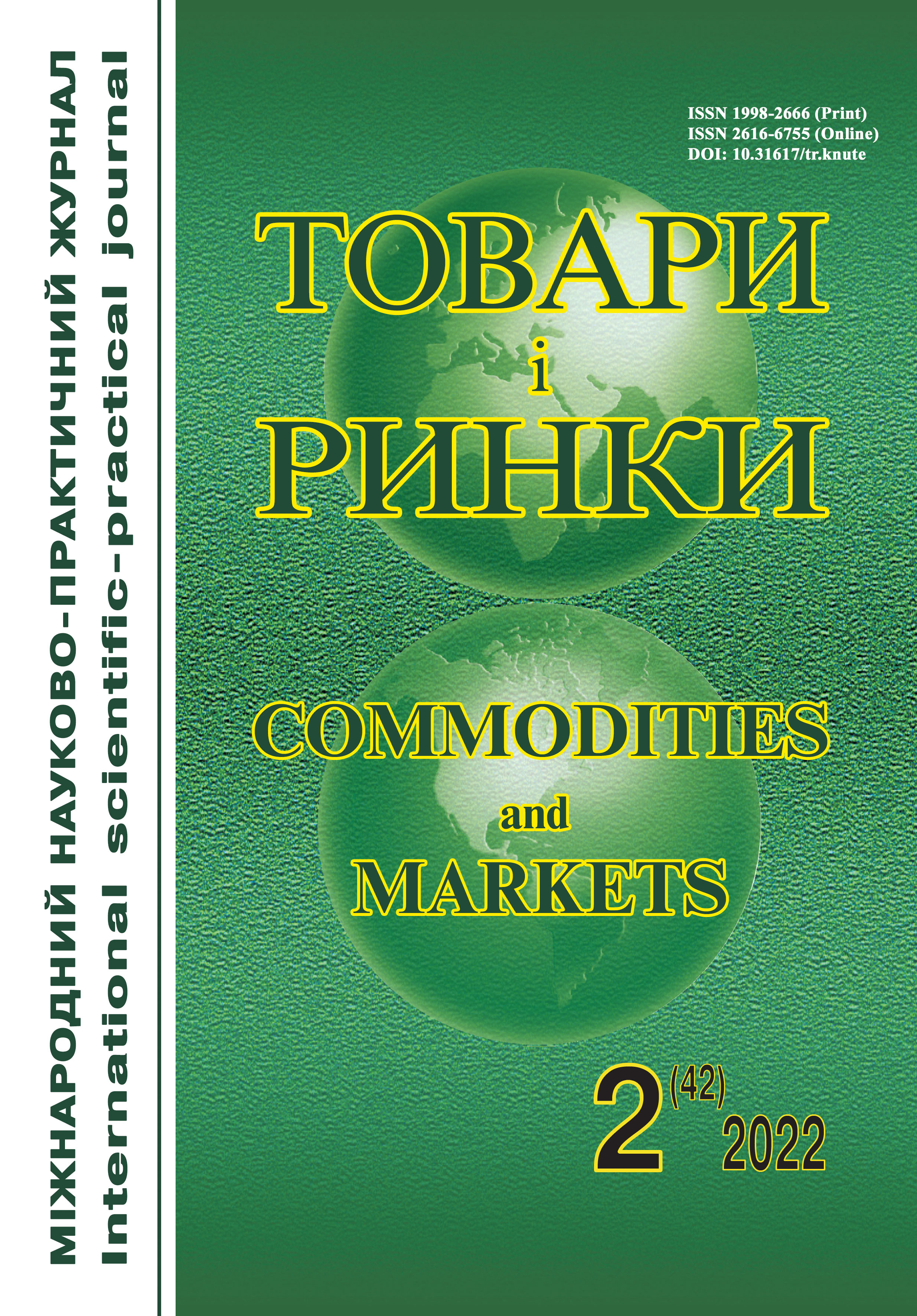Contactless economics: a theoretical phenomenon and the practice of formation
DOI:
https://doi.org/10.31617/2.2022(42)02Keywords:
contactless economy, martial law, behavioral changes, changes in consumer behavior, innovative technologies, digitalization.Abstract
Introduction. The contactless economy model (CEM) has become an effective solution in response to structural changes in the economies of many countries. In Ukraine, it has a wider and more intensive application as a result of events caused by full-scale military aggression by Russia Federation. As the tools of the contactless economy have previously been used to adapt to post-pandemic conditions and have had results, their use is now considered one of the most effective for both business and consumers.
Problem. In conditions of limited economic activity due to hostilities in some regions of Ukraine and the constant threat to the lives of the population, there is a problem of rapid adaptation by business and, in particular, changes in the nature of economic relations. In this case, the CEM is a relevant and effective option.
The aim of the article is to determine the characteristics of the contactless economy model; finding out the mechanism of functioning of the CEM and the tools that can be used during its operation; identification of trends in consumer
behavior in martial law; systematization of practical experience of using the chosen model.
Methods. The method of scientific abstracttion, historical and analytical methods are used; modeling; experimental.
Results. One of the ways to adapt business and other economic agents to martial law through the use of CEM is outlined. The preconditions for the emergence of this concept and changes in consumer behavior, which became the basis for the creation of CEM, are analyzed. The main tools of contact between economic agents are highlighted. For further adaptation of the chosen
model in modern realities the mechanism of its functioning is shown.
Conclusions. It is determined that CEM, although relatively new, but effective in its application, its tools are used by many global
companies. It is especially relevant for Ukraine, taking into consideration the military operations that actually limit the economic activities of economic entities.
References
Board of Innovation. The winners of the low touch economy: how companies can recover and grow in the new normal. https://ru.calameo.com/read/0054192602a096fed1d24?view=slide&page=1 [in English].
Alfonso, V., Boar, C., Frost, J., Gambacorta, L., & Liu, J. (2021). E-commerce in the pandemic and beyond. BIS Bulletins, 36, 1-9 [in English].
Di Crosta, A., Ceccato, I., Marchetti, D., La Malva, P., Maiella, R. et al. (2021). Psychological factors and consumer behavior during the COVID-19 pandemic. Plos one. (Vol. 16), 8, 1-23 [in English].
Guthrie, C., Fosso-Wamba, S., & Arnaud, J. B. (2021). Online consumer resilience during a pandemic: An exploratory study of e-commerce behavior before, during and after a COVID-19 lockdown. Journal of Retailing and Consumer Services. (Vol. 61), (pp. 1-15) [in English].
Ivkovic, N. (2021). Beyond the pandemic – a new era of consumer behavior. 65th International Scientific Conference on Economic and Social Development [in English].
Grycenko, A. (2018). Cyfrovyj rozvytok: struktura, kapitalizacija ta socializacija [Digital development: structure, capitalization and socialization]. Ekonomichna teorija – Economic theory, 4, 5-20 [in Ukrainian].
Mazaraki, A., & Volosovych, S. (2018). FinTech u systemi suspil’nyh transformaciy̆ [FinTech in the system of social transformations]. Visnyk Kyı̈vs’kogo nacional’nogo torgovel’no-ekonomichnogo universytetu – Herald of the Kyiv National University of Trade and Economics, 2, 5-18 [in Ukrainian].
Gerasymenko, A. G. (2020). Nova normal’nist’ ekonomiky HHI st. [New normality of the economy of the XXI century]. Visnyk Kyi’vs’kogo nacional’nogo torgovel’noekonomichnogo universytetu – Herald of the Kyiv National University of Trade and Economics, 3(131), 5-26. DOI: http://doi.org/10.31617/visnik.knute.2020(131)01 [in Ukrainian].
Lagutin, V. D. (2020). Ontologichni ta gnoseologichni zasady ekonomichnoi’ nauky XXI stolittja [Ontological and epistemological principles of economics of the XXI century]. Visnyk Kyi’vs’kogo nacional’nogo torgovel’no-ekonomichnogo universytetu – Herald of the Kyiv National University of Trade and Economics, 2, 21-35. DOI: http://doi.org/10.31617/visnik.knute.2020(130)02 [in Ukrainian].
Umanciv, Ju. M. (2019). Ekonomichna teorija u novitn’omu metodologichnomu dyskursi [Economic theory in the latest methodological discourse]. Visnyk Kyi’vs’ – kogo nacional’nogo torgovel’no-ekonomichnogo universytetu – Herald of the Kyiv National University of Trade and Economics, 2, 51-63. DOI: http://doi.org/10.31617/visnik.knute.2019(124)03 [in Ukrainian].
Shrestha, N., Shad, M.Y., & Ulvi, O. (2020). The impact of COVID-19 on globalization. One Health. (Vol. 11), (pp. 1-31) [in English]. Global Consumer Insights Survey 2020. https://www.pwc.com/gx/en/consumer-markets/consumer-insights-survey/2020/pwc-consumer-insights-survey-2020.pdf [in English].
Golovni trendy na karantyni: shho zminylos’ v povedinci ukrai’nciv [The main trends in quarantine: what has changed in the behavior of Ukrainians]. https://www.epravda.com.ua/publications/2020/04/14/659337 [in Ukrainian].
The Low-Touch Economy – What it is and why it’s important for your business. https://www.spica.com/blog/covid-shield-low-touch-economy [in English].
Tan, S. K. (2021). Global Pandemic, Technology Booms and New Business Trends: The Case of Japan. International Journal of East Asian Studies. (Vol. 10), 1, 120-140 [in English].
Masks No Obstacle for New NEC Facial Recognition System. https://www.reuters.com/article/us-health-coronavirus-japan-facial-recog-idUSKBN29C0JZ [in English].
Nahornyi, P. (2021). Fintech: trends and prospect of development in the transition to a touchless economy. Black Sea Science. (pp. 347-359) [in English].
ISSN 1998‐2666; eISSN 2616‐6755. Товари і ринки. 2022. №2
The World Bank Data. GDP growth Ukraine. https://data.worldbank.org/indicator/NY.GDP.MKTP.KD.ZG?end=2020&locations=UA&start=2014 [in English].
Zakon Ukrai’ny "Pro vnesennja zmin do dejakyh zakonodavchyh aktiv Ukrai’ny, sprjamovanyh na zabezpechennja dodatkovyh social’nyh ta ekonomichnyh garantij u zv’jazku z poshyrennjam koronavirusnoi’ hvoroby (COVID-19)" [Law of Ukraine "On Amendments to certain Legislative Acts of Ukraine aimed at providing additional social and economic guarantees in connection with the spread of coronavirus disease (COVID-19)"]. https://zakon.rada.gov.ua/laws/show/540-20#Text [in Ukrainian].
Podatkovyj Kodeks Ukrai’ny [Tax Code of Ukraine]. zakon.rada.gov.ua. https://zakon.rada.gov.ua/laws/show/2755-17#Text [in Ukrainian].
Nacional’nyj bank Ukrai’ny [National Bank of Ukraine]. https://bank.gov.ua [in Ukrainian].
Lebedeva, L. V., & Romanenko, V. A. (2021). Vyklyky COVID-19 dlja promyslovosti Ukrai’ny ta krai’n JeS [COVID-19 challenges for industry in Ukraine and the EU countries]. Efektyvna ekonomika – Efficient economy, 6. http://www.economy.nayka.com.ua/?op=1&z=8973 (data zvernennja: 23.03.2022) [in Ukrainian].
Derzhavna sluzhba statystyky Ukrai’ny [State Statistics Service of Ukraine]. http://www.ukrstat.gov.ua [in Ukrainian].
Bakhnivskyi, V., & Ignashchuk, O. (2020). Ukrainian response to the COVID-19 pandemic: governmental interventions. Zdrowie Publiczne i Zarzadzanie. Zeszyty Naukowe Ochrony Zdrowia. (Vol. 18), 1, 80-87 [in English].
Global Innovation Index 2021. https://www.wipo.int/global_innovation_index/en/2021 [in English].



